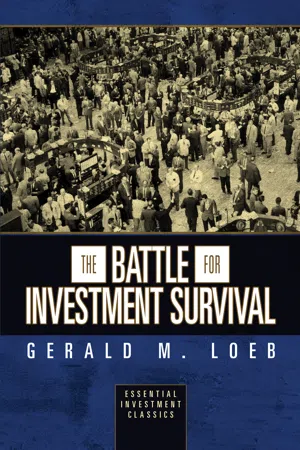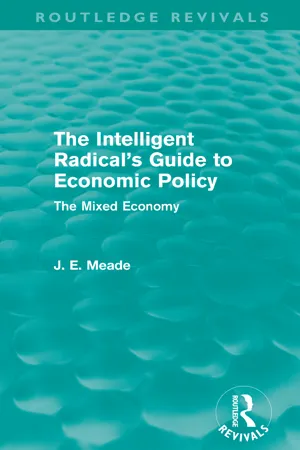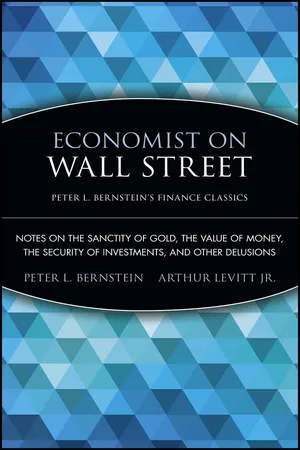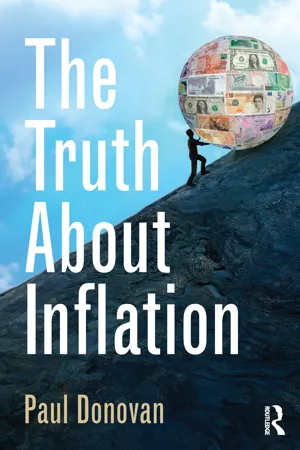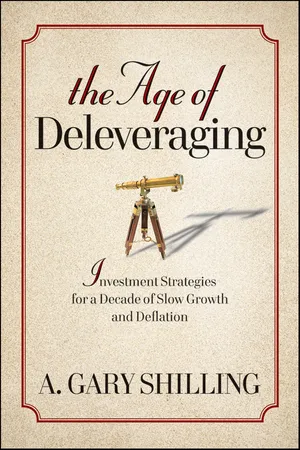Economics
Costs of Inflation
The costs of inflation refer to the negative impacts that rising prices can have on an economy. These costs include reduced purchasing power, uncertainty for businesses and consumers, and distortions in the allocation of resources. Inflation can also lead to higher interest rates and reduced real returns on savings and investments.
Written by Perlego with AI-assistance
7 Key excerpts on "Costs of Inflation"
Learn about this page
Index pages curate the most relevant extracts from our library of academic textbooks. They’ve been created using an in-house natural language model (NLM), each adding context and meaning to key research topics.
- Gerald M. Loeb(Author)
- 2020(Publication Date)
- G&D Media(Publisher)
INVESTMENT AND INFLATIONT he changing purchasing power of money, coupled with the rise and fall of prices and costs, are the most basic and far reaching causes for fluctuations in the earning power and value of security investments and security market prices.“Inflation” means an increase in the supply of money or credit so that prices for goods go up. Increasing commodity prices and increasing costs of living however can also be caused by increasing demand for goods and services or shortages in supply,“Deflation” means a decrease in the supply of money or credit so that prices for goods go down. Decreasing commodity prices and decreasing costs of living however can also be caused by decreasing demand for goods and services or surpluses in supply.In addition to many other contributing causes of inflation or deflation, a very great factor is the psychological. The fact that people think prices are going to advance or decline, very much contributes to their movement, and the very momentum of the trend itself tends to perpetuate itself.The effects of inflation or deflation are first a great shifting of wealth. The total real wealth of a nation cannot be measured in either dollars or prices, but more in unit production and consumption. Judged quantitatively, inflation in its early stages tends to stimulate both production and consumption, and to create a general feeling of prosperity and well being. However, judged individually, there is of course a redistribution of wealth as between the debtor and the creditor, rich and poor, entrepreneur and wage earner, speculator and investor. Once inflation really takes hold, and results in real currency depreciation then, for the majority, only complete financial ruin and extreme emotional uncertainty follow.The control of inflation is rarely attempted at its roots, where control is possible, but practically always is instead incorrectly directed at its effects, where such efforts invariably fail. If it runs far enough, it brings its own cure, only by that time the patient is dead.- eBook - ePub
- Thomas Crump(Author)
- 2011(Publication Date)
- Routledge(Publisher)
This explains why ‘cost-push’, which is the alternative to ‘demand-pull’ inflation, is much easier to live with. In any sector to which it applies, it means that the prices of outputs have to be increased ‘defensively’, simply because of the increased cost of inputs—such as labour, or imported raw materials (Flemming, 1976, p. 12). Everything is blamed on the trade unions, or on the OPEC lands (particularly those whose religion is Islam). This latter case has the advantage of being able to show that the inflation is triggered off from outside the sphere of payment, allowing the authorities to adopt a convenient air of injured innocence.In considering the causes of inflation one is confronted with a vicious circle. There are quite logical arguments to prove that neither ‘cost-push’ nor ‘demand-pull’ can be a cause of inflation (Machlup, 1969, pp. 151f.). Inflation is in fact a vicious circle, and ‘demand-pull’ and ‘cost-push’ are little more than two sides of the same coin. So also, once inflation is started, is it difficult to distinguish between cause and effect, a point to be borne in mind in the following section.The consequences of inflation
The consequences of inflation are twofold: the redistribution of purchasing power and the revaluation of assets and liabilities. As to the first, each separate sector in the economic complex sees its money income increased at different stages in the inflationary cycle. For every such sector two factors are critical: the first is the amount of the increase accruing to it; the second, the time at which it occurs. The significance of the first factor may be evaluated in terms of the share of the sector concerned in the aggregate flow of money—MV in Fisher’s equation. The immediate result of an increase in the income accruing will be to increase this share, and although this must lead to a decrease in the share of other sectors, this need involve no loss in real terms so long as it corresponds to a rateable increase in productivity. That is, an increase in MV is not inflationary, so long as it leads only to an increase in T, with P remaining unchanged. If, however, this does not happen (which is the general case), the increase in P - eBook - ePub
- James E. Meade(Author)
- 2012(Publication Date)
- Routledge(Publisher)
II
The Control of Inflation
A necessary condition for the design of an effective set of radical economic policies and institutions is the existence of a monetary unit of account with a more or less dependable, stable, real purchasing power. Accordingly in this chapter we shall attempt to outline : first, the mechanisms of price inflation; second, the disadvantages, particularly for the radical’s set of policies, of price inflation; and, third, in the light of the mechanisms and disadvantages of inflation the design of policies for the control of inflation by means which will help rather than hinder the intelligent radical’s package of other economic policies.By inflation we mean simply a rise in the general level of money prices of goods and services. The causes of an inflationary situation are often divided into two groups, namely those which originate from a demand inflation and those which originate from a cost inflation. It is convenient to consider the phenomenon of price inflation under these two broad headings, though, as we shall see, the two types of inflation are in fact very closely interconnected.A demand inflation occurs when there is ‘too much money chasing too few goods’. The total demand for the goods and services produced in a country can be catalogued under the following four heads : (1) the expenditure by individual citizens for the purchase of domestically produced goods and services for individual consumption – food, clothing, heating, and other consumption goods; (2) the expenditure by business concerns on domestically produced buildings, machinery, plant, and other equipment in order to invest in additional productive capacity; (3) the purchase by the government and local authorities of domestically produced goods and services for public purposes; and (4) the purchase by foreigners of exports of the country’s domestically produced goods and services. - eBook - ePub
Economist on Wall Street (Peter L. Bernstein's Finance Classics)
Notes on the Sanctity of Gold, the Value of Money, the Security of Investments, and Other Delusions
- Peter L. Bernstein(Author)
- 2008(Publication Date)
- Wiley(Publisher)
The period of the largest increase in the cost of living, 1946-1948, saw stock prices rise only 5 percent; the period of the smallest increase in the cost of living, 1954-1956, saw stock prices rise 50 percent. All of this is confirmed by recent European experience, where the degree of price inflation has been three to four times as intense as our own and has been accompanied by prolonged and deep declines in the prices of common stocks.This is, in short, a subject in which unsophisticated oversimplification is likely to be wrong and even positively dangerous.The causes and consequences of inflation are more complex and obscure than the average level of Wall Street conversation might suggest.Yet, we may be able to uncover a possible, although by no means certain, solution to the riddle of why the prices of goods and services rose so much from 1957 to 1961 when the pressure of inflationary forces was so much less than it was from 1961 to 1965. The following little table should make this clear:Thus, with wages rising faster and productivity more slowly in the earlier period, the increase in labor cost per unit of output was obviously much greater than it was in the following four years. This provides another ironic twist: Who would have expected wages to go up more when unemployment was growing than when it was shrinking?These data suggest other intriguing links among the various parts of the economic process. The combination of tax cuts (including the investment credit) and an expansionary monetary policy surely contributed to the more rapid growth in the demand for goods and services in the later period. This in turn created the proper environment for businessmen to be willing to take the risks of sinking more money into capital equipment, thereby leading in turn to greatly improved productivity. The consequent easing of the upward pressure of costs meant more stable prices—and this moderated the demands of the unions for higher wages.In the present conjuncture of events, a fundamental inflationary condition is intensified by an increasingly militant stand on the part of the unions. This is only in part a result of the somewhat more rapid rise in living costs in recent months; it is due more to the bulging levels of corporate profits that developed out of the 1961-1965 experience. The ditching of the guidelines is an ominous omen of things to come, in which wages and prices may once again move up under conditions of slower economic growth, as they did during the 1957-1961 period. Indeed, the dangers in a too restrictive fiscal or monetary policy lie precisely in discouraging businessmen from making the capital investments that are so essential to cost reduction and productivity improvements. - eBook - ePub
- Paul Donovan(Author)
- 2015(Publication Date)
- Routledge(Publisher)
This then loops back to the equity market. A weaker currency may not boost real economic activity (as measured by GDP). However, a weaker currency could boost profits for exporters, by allowing them to translate foreign earnings into the local currency at a favourable rate. That could be an important aspect in judging a company’s profitability. At the same time, if the price of imported commodities (especially energy) starts to rise as a result of higher inflation that will impact other companies, and may impact the consumer’s willingness to spend. Foreign exchange market shifts are likely to encourage relative price shifts that impact different companies in different ways – good for exporters, bad for those that import commodities.So what is the true story of inflation?
In the aftermath of the global financial crisis, inflation has been subdued in most of the major industrialised economies. Indeed, the fear of deflation has emerged in some economies. This does not mean that inflation can now be pushed to one side by an investor as some kind of quaint anachronism of times past. In a world where overall investment returns are likely to be lower than they have been in the past, small differences in the inflation rate can play a far more important role in determining relative standards of living than in the past. In a world where investment returns of 7 per cent are easy, a 1 per cent difference in inflation is not necessarily a major concern. In a world where investment returns of 4 per cent are more normal, a 1 per cent difference in inflation suddenly assumes more importance in the mind of the investor. In all likelihood, phenomena such as inflation inequality are going to continue in the future. This makes 1 per cent variations in inflation – at least in the true inflation faced by a discriminating investor – just as probable in the future as in the past. The difference from the past is that in the modern world those relatively small inflation variations matter more to investment strategies. - eBook - ePub
Inflation, Income Distribution and X-Efficiency Theory
A Study Prepared for the International Labour Office...
- Harvey Leibenstein(Author)
- 2022(Publication Date)
- Routledge(Publisher)
A number of developing countries depend on trade in primary products for which significant substitutes exist, such as coffee, cocoa, rice, etc. These are to be contrasted to such products as oil, for which substitution is much more difficult. In cases of sensitive primary products, it is usually possible for governments to manipulate the price received by farmers versus the price that goods sell for on international markets and, as a result, this is likely to be an area where the political aspects of inflation will be significant.An unusual aspect of the literature on the impact of inflation on developing countries is that there is almost no systematic work available. In particular, systematic work which assessed the gains and losses to various segments of the population as a consequence of inflation should exist, and is certainly feasible, but is absent. A systematic analysis would look upon the inflation process as a zero-sum game which takes real income from some and distributes it to others. Even if this were done on a group-by-group basis, it would only average the gains and losses of the different groups, despite the fact that there are gains and losses within any group. Even this sort of information would be extremely revealing. Yet, from an empirical viewpoint, no studies of this sort exist. Although, once the question is raised (and it seems an obvious one), it suggests some obvious types of exercises and calculations; if not raised, it simply does not seem to come up as an important intellectual issue among development economists. Most of the work concentrates on the causes of inflation rather than on the consequences. Perhaps part of our difficulty in understanding causes of inflation is because so little systematic work has been done on the consequences.There are of course intrinsic difficulties in doing the sort of studies suggested in the previous paragraph. The data are not likely to come in pure form, but are likely to involve changes as a consequence of economic growth and decline, as well as the differential productivity of different sectors. In other words, actual economic operations work normally as positive-sum games in some periods and as negative-sum games in others. In order to express the purely redistributive aspects of inflation, we would have to find a means of separating the non-zero-sum aspects out of the data to arrive at the net zero-sum consequence involved. - eBook - ePub
The Age of Deleveraging
Investment Strategies for a Decade of Slow Growth and Deflation
- A. Gary Shilling(Author)
- 2010(Publication Date)
- Wiley(Publisher)
Figure 1.5 in Chapter 1).Inflation BiasesFurthermore, we all tend to have inflation biases. We worry more about rising prices that may strain household budgets than about falling prices, which can help them. Maybe that's why we tend to think that whenever we pay higher prices, it's because of the inflation devil himself, but that lower prices are a result of our smart shopping and bargaining skills. Airline ticket costs may be falling due to competition from discount airlines, but many people think they're responsible for their cheaper tickets as they visit airfare web sites and pick the lowest fares. Meanwhile, higher prices are seen as being the work of greedy corporations and other unassailable forces. Who doesn't feel helpless, both physically and financially, in the face of rising medical costs?Also, we don't calculate the quality-adjusted price declines that result from technological improvements in many big-ticket purchases. This is especially true since many of those items are bought so infrequently that we have no idea what we paid for the last one. But we sure remember the cost of gasoline on the last fill-up a week ago.Nevertheless, concentration on small purchases neglects the big price declines in recent years in expensive, infrequently purchased items that are often discretionary and can be postponed. New and used vehicles are in this category (see Figure 8.1 ). Computers are in the same boat, and adjusted for skyrocketing in computing power, their cost to consumers has virtually collapsed in the past 25 years while they have become more and more important expenditures.Figure 8.1 New and Used Automobile Prices, Year/Year Percent ChangeData source: Bureau of Labor Statistics.Quality improvements are also important on lower-tech products. Even if a washing machine costs the same as a decade ago, the modern front-loading models are more convenient and use less energy and water. These quality enhancements are often forgotten even if people remember what they paid 10 years ago.
